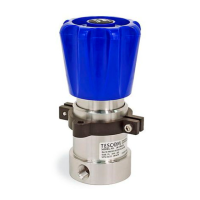14
Section 3
Rev. 06/15
Safety, Installation, Operations & Service Manual
DOPSM2080X012
3.4.4 Maintenance
The following procedures are provided to enable the customer to perform all normal
maintenance and repair operations. These operations are more easily performed with the
regulator removed from the line. However, in some cases repair may be accomplished
without removal of the regulator body as long as the supply has been shut off and the inlet
and outlet pressures have been vented.
An Assembly Drawing and Bill of Material for the regulator will be needed to complete
maintenance procedures. The Assembly Drawing and Bill of Material are separate from this
manual and available by contacting TESCOM (see pg. 39 for TESCOM contact information).
The following steps outline the disassembly of back pressure regulators for maintenance
and repair:
1. Clamp the regulator in a vise by the flats on the bottom and/or side of the regulator
body.
2. Turn control knob and/or spring adjustment mechanism counterclockwise to insure
removal of all spring force on the diaphragm.
NOTE: (Dome loaded regulators) All pressurized gas or liquid must be vented from dome
before disassembly.
3. Remove upper portion of regulator (bonnet and/or dome). Some models require the
mounting bracket to be removed first.
NOTE: Upper portion of regulator may also include spring button, load spring back-up
plate, and diaphragm, etc. Review correct drawing to ensure that all parts have been
disassembled.
4. The valve parts can now be removed from the regulator body by turning the seat
retainer and/or back cap counterclockwise until it is free of the regulator body.
5. To disassemble diaphragm valve assembly and/or valve, clamp valve in smoothed jaw
vise. Clamping should be done on flats.
Care must be used to not damage valve.
3.4.5 Reassembly
The regulator is reassembled in the reverse order of disassembly, observing the following
precautions. Please reference the Bill of Material and Assembly Drawing for the correct
location of replacement parts and correct torque specifications.
1. Inspect all parts and replace those worn or damaged with TESCOM replacement parts.
2. All parts should be cleaned to the cleanliness level required for safe operation with
the media and system they will be used in. All parts in the flow stream must be free of
particles which could prevent proper seating of the main valve.
3. Apply a thin uniform coating of fluorocarbon grease to any or all of the following parts:
Indentation of spring button, threaded portion of adjusting screw, entire threaded area
of the bonnet, all O-rings, all threaded parts internal to regulator.
